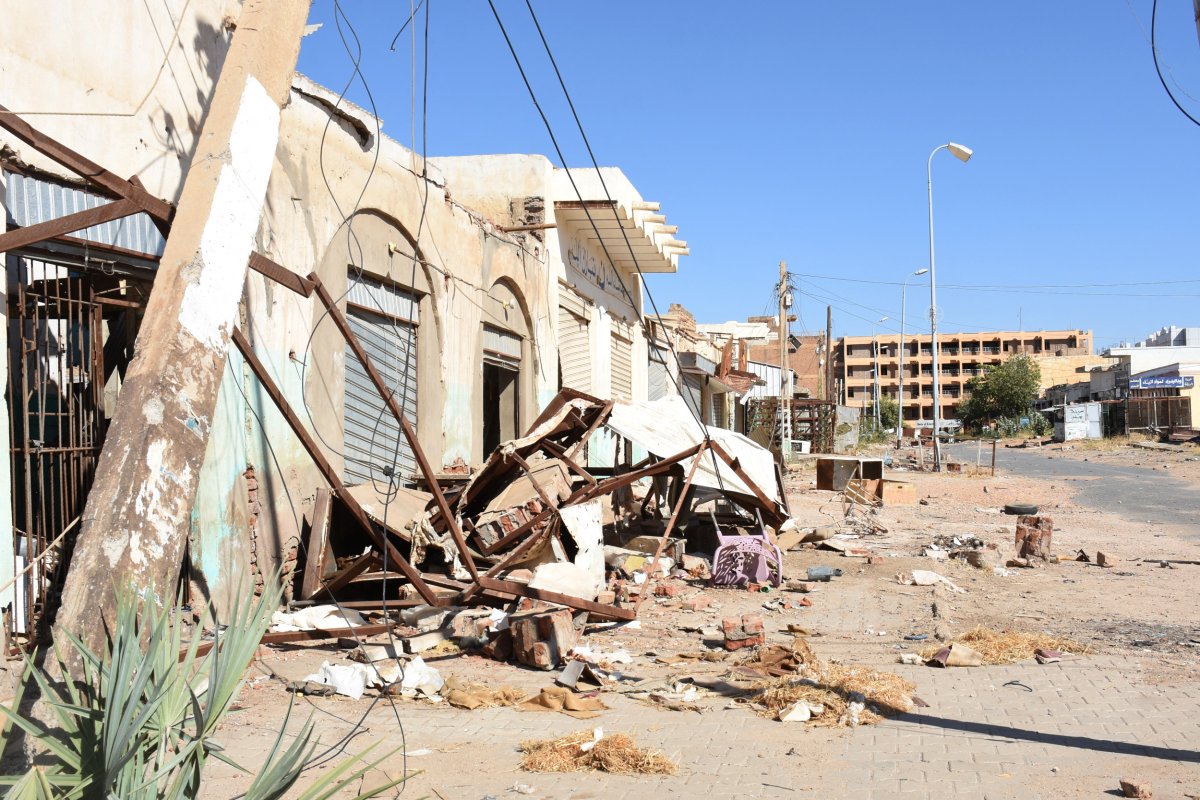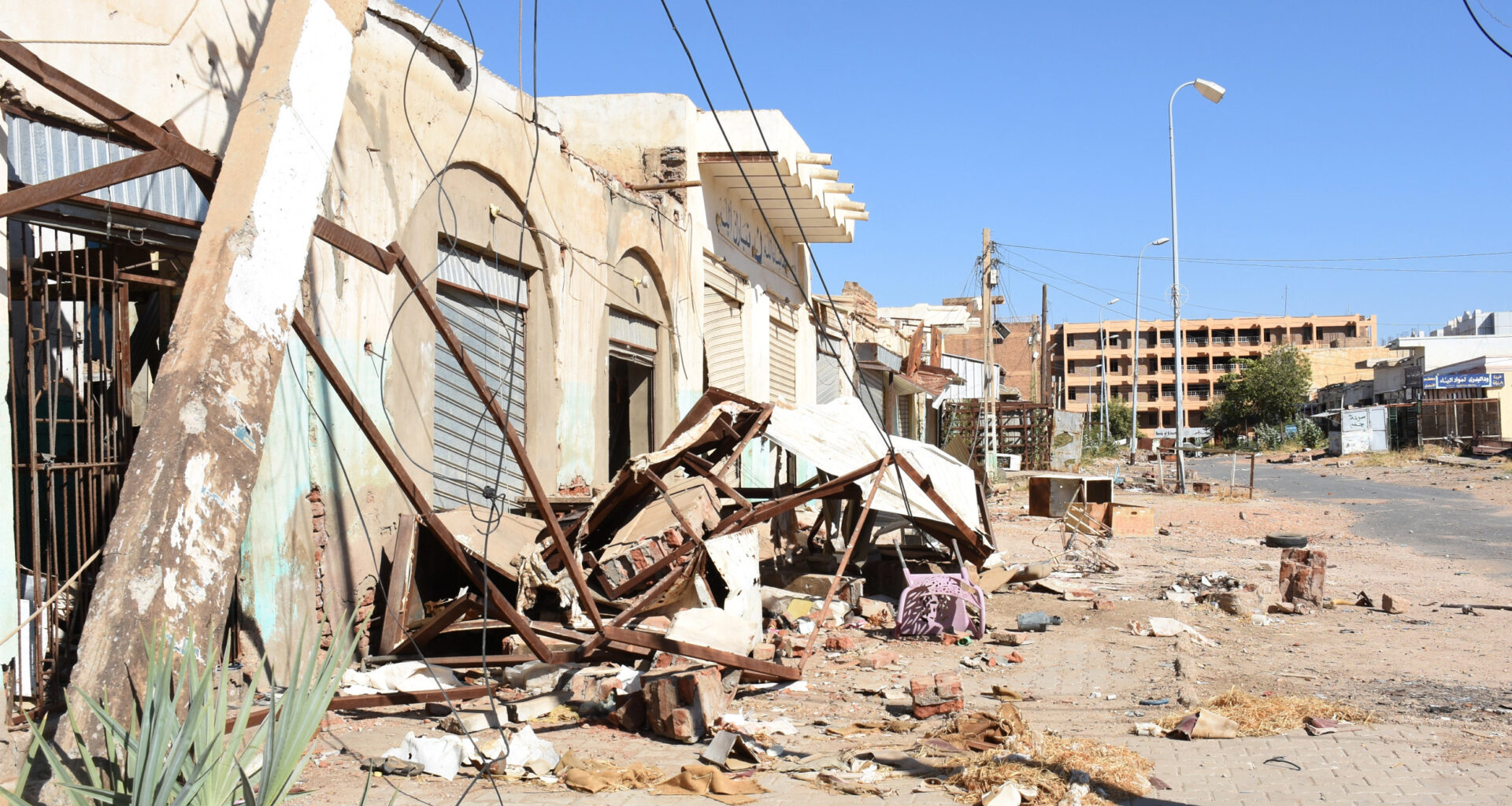The United States’ declaration of genocide in Sudan marked a crucial moment of recognition. While this designation appropriately highlighted the deliberate targeting of civilians by the Rapid Support Forces (RSF), we risk missing an equally devastating dimension of this crisis—the unprecedented convergence of climate collapse with health system destruction that threatens to outlast any peace agreement.
Since fighting erupted in April 2023, over 11 million people have fled their homes in what the U.N. calls the world’s largest displacement crisis. Eight million remain internally displaced, while 3 million have sought refuge in neighboring countries, straining already scarce resources across the region. The Integrated Food Security Phase Classification has confirmed famine in Sudan’s North Darfur region, with more than 24.6 million people—over half the country’s population—facing acute food insecurity.

A picture taken on January 19, 2025, shows a general view of damaged shops and houses in Sudan’s Al-Jazira state capital Wad Madani following its takeover by the army from paramilitary Rapid Support Forces (RSF).
A picture taken on January 19, 2025, shows a general view of damaged shops and houses in Sudan’s Al-Jazira state capital Wad Madani following its takeover by the army from paramilitary Rapid Support Forces (RSF).
AFP via Getty Images
Research by the U.N. Environment Program reveals that 40 percent of Sudan’s internal conflicts since independence have been linked to environmental resource competition, a pattern that climate change has transformed into an acute crisis. Rising temperatures and erratic rainfall have devastated farming communities and severed vital food supply chains, pushing already vulnerable populations into famine conditions that are unprecedented in scale and severity.
The decimation of Sudan’s health infrastructure has created a perfect storm. In conflict zones, 80 percent of hospitals are non-functional, while the remaining facilities struggle with overwhelming demand. Health workers have fled or become casualties of the conflict, leaving millions without access to basic care. The consequences are stark. Cholera has reemerged in repeated waves, and a recent study showed 90 percent of citizens experiencing moderate to severe anxiety and depression. Most alarming is the impact on children—between May and July 2023 alone, 1,200 children under 5 died in just nine refugee camps due to malnutrition and measles. The collapse of vaccination programs threatens to undo decades of progress against preventable diseases.
Climate change acts as a threat multiplier, turning every aspect of survival into a deadly challenge. In August 2024, flooding affected half a million people, half of whom were already displaced by fighting. These floods triggered cholera outbreaks in camps where medical care is virtually nonexistent. Meanwhile, rising temperatures expand the range of disease vectors, bringing malaria and dengue to populations with no access to preventive care. In regions like Darfur and eastern Chad where Sudanese refugees have fled, competition over scarce environmental resources has ignited further conflicts, perpetuating cycles of violence and displacement. The environmental stress has become so severe that traditional coping mechanisms and community resilience strategies are breaking down.
The solutions must be as interconnected as the crises themselves. Immediate intervention is needed to protect and restore health systems through climate-resilient medical facilities and mobile clinics. These facilities must be designed with rising temperatures in mind, incorporating passive cooling systems and backup power.
Beyond health care, climate adaptation must be integrated into humanitarian responses through drought-resistant agriculture, water conservation technologies, and early warning systems for extreme weather events. Local communities must be trained in sustainable resource management to reduce competition over scarce resources, while receiving support to revive traditional environmental knowledge that has helped communities survive previous climate challenges.
Mental health infrastructure demands urgent attention, with just 34 psychiatrists serving a population of 43 million before the war. Training community health workers in basic mental health support and implementing telemedicine initiatives could help bridge this gap. The psychological impact of displacement, violence, and environmental loss requires both immediate intervention and long-term support systems. With 6.7 million women and girls at risk of gender-based violence, we also need dedicated women’s health clinics and safe spaces in refugee camps, including well-lit water collection points to reduce exposure to violence.
The genocide designation, while important, must not overshadow these broader catastrophes. The international community must simultaneously address the climate and health crises that threaten to make any peace unsustainable. This requires dramatically increased humanitarian funding and logistical support, particularly for food, water, and shelter. Current aid levels meet less than half of the urgent needs on the ground.
Moreover, any lasting solution must address the root causes of conflict through local governance structures that can fairly manage resource distribution and ensure marginalized communities have a voice in decision-making processes. These governance systems must be designed to withstand both political pressures and environmental stresses.
Sudan’s crisis offers a preview of how climate change and health care collapse can transform political conflicts into comprehensive humanitarian catastrophes. As climate change intensifies and health systems worldwide face mounting pressures, the international community must develop integrated approaches that recognize how these forces intersect and compound each other. Sudan’s tragedy has shown us that traditional humanitarian responses are insufficient for modern crises where violence, climate change, and health collapse create mutually reinforcing cycles of suffering. The time for comprehensive action is now—before this pattern repeats elsewhere in our warming world.
Thurka Sangaramoorthy is professor and chair of the Department of Anthropology at American University.
The views expressed in this article are the writer’s own.
